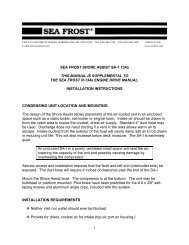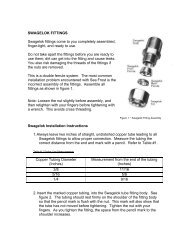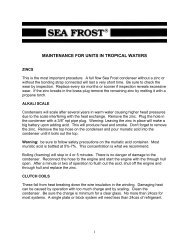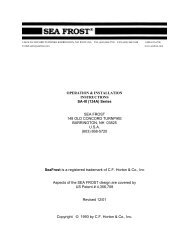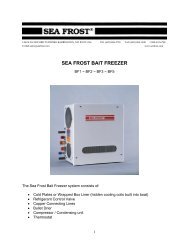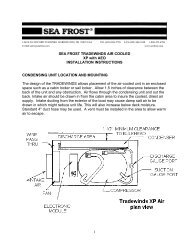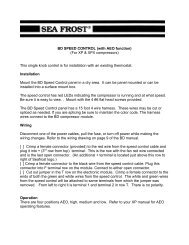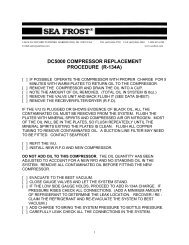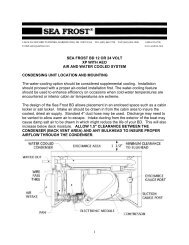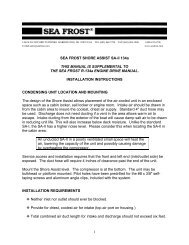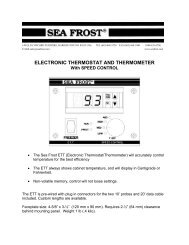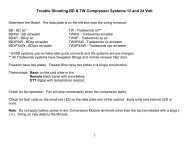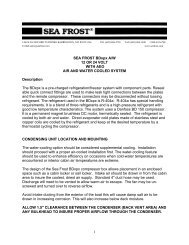ETT Manual - Sea Frost Refrigeration
ETT Manual - Sea Frost Refrigeration
ETT Manual - Sea Frost Refrigeration
You also want an ePaper? Increase the reach of your titles
YUMPU automatically turns print PDFs into web optimized ePapers that Google loves.
148 OLD CONCORD TURNPIKE BARRINGTON, NH 03825 USA TEL (603) 868-5720 FAX (603) 868-1040 1-800-435-6708<br />
E-Mail:sales@seafrost.com<br />
www.seafrost.com<br />
ELECTRONIC THERMOSTAT AND THERMOMETER<br />
• The <strong>Sea</strong> <strong>Frost</strong> <strong>ETT</strong>’s (Electronic Thermostat/Thermometer) accurate<br />
operating settings and the programmable differential increases<br />
efficiency. In comparison, mechanical controls tend to over run the<br />
desired temperature range and must be set colder, running the<br />
compressor longer, to maintain the proper average temperature.<br />
• The <strong>ETT</strong> will operate any <strong>Sea</strong> <strong>Frost</strong> electrical compressor system, AC<br />
or DC.<br />
• The <strong>ETT</strong> always shows cabinet temperature, and will display in<br />
Centigrade or Fahrenheit.<br />
• Accurate numerical setting of operating temperatures and differential<br />
makes set up and temperature adjustment easy.
• Thermometer mode.<br />
• Wire leads allow mounting any distance from cabinet.<br />
• Black faceplate with red L.E.D. operation indicators.<br />
• Non-volatile memory, control will not loose settings.<br />
The <strong>ETT</strong> is pre-wired with plug in connectors for the two 10’ probes and<br />
(custom length) data cable included.<br />
The left hand rocker switch turns on the display. The right hand switch<br />
activates the control relay. Red L.E.D.s indicate ON and RUN modes.<br />
Faceplate size: 4 5/8” x 3 ½” (120 mm x 90 mm). Requires 2 ½” (64 mm)<br />
behind mounting panel. Weight 1 lb (.4 kilo).<br />
CLEANING<br />
Do not use acetone or any solvent on the control panel, clean with a damp<br />
cloth and mild detergent.<br />
INSTALLATION AND OPERATION MANUAL<br />
OPERATION<br />
The <strong>Sea</strong> <strong>Frost</strong> Electronic Thermostat and Thermometer (<strong>ETT</strong>) is an<br />
electronic device using two probes installed in the refrigerated space. One<br />
probe is sensing the cabinet temperature, which is displayed. The other<br />
probe controls the compressor operation by measuring the temperature of<br />
a cold plate.<br />
To operate the control, switch both rocker switches to the left position (off).<br />
Make sure power is available then push the left rocker switch to the right<br />
(on). The display will light and the temperature will be displayed. To switch<br />
on the compressor controlled by the <strong>ETT</strong>, switch the right switch to the on<br />
position. Both red indicators will light indicating the compressor switch is<br />
on and the compressor is running. When the compressor cools to the pre-<br />
2
set cut out temperature the RUN indicator light will go off with the<br />
compressor. The ON indicator light will remain lit indicating a standby or<br />
ready to run mode.<br />
To display temperature only turn off the right ON/RUN switch.<br />
To turn off both the temperature readout and compressor the left switch<br />
may be used however when turning it back on the compressor will start<br />
immediately. All settings will always be saved.<br />
CHECKING THE TEMPERATURE S<strong>ETT</strong>ING<br />
Before adjusting the thermostat be sure the refrigeration system is working<br />
properly.<br />
The <strong>ETT</strong> can be adjusted and will maintain very stable temperatures. Care<br />
must be taken to adjust the settings to maintain obtainable temperatures.<br />
In initial testing do not set below -10 F. (–23 degrees C.) Excessive<br />
compressor running will occur with no benefit if the setting is below the<br />
temperature the compressor system can easily obtain.<br />
To check the cut out setting (cold stopping point) push and hold the SEL<br />
button until ST-1 appears. Release the button and a number will flash.<br />
This is the cut out temperature. Push SEL again and the readout will return<br />
to box temperature. The cut out temperature is associated with the second<br />
probe (red banded). This probe read out temperature is hidden. (Press and<br />
hold the down arrow button to view this read out temperature.)<br />
CHECKING THE PLATE PROBE TEMPERATURE<br />
To monitor the cooling progress, push in and hold the down arrow button.<br />
The plate probe temperature will be displayed while this button is held.<br />
RECOMMENDED S<strong>ETT</strong>INGS<br />
The air temperature in a refrigerator is always 10 to 15 degrees F. (6 to 9<br />
C.) warmer than the cooling device. This difference in temperature must be<br />
remembered when setting the control cut out temperature (stopping point).<br />
A refrigerator might have to be set to run up to 20 degrees colder than the<br />
desired box temperature.<br />
3
Make several small setting changes over a period of several days to<br />
determine the proper setting.<br />
CHANGING THE TEMPERATURE<br />
To lower or raise the box temperature, hold the SEL button until the ST-1<br />
appears. Release the button and the cut out temperature will flash. Use<br />
the up and down arrows to change the temperature. Push SEL when<br />
finished. The control setting has now been changed.<br />
THE DIFFERENTIAL S<strong>ETT</strong>ING<br />
The differential is the number of degrees the temperature must rise before<br />
the compressor will come back on after cooling to the set point. The<br />
factory test setting is 6 degrees F. (4.5 C.)<br />
To change the differential setting press and hold PRG until P 1 is<br />
displayed, then press SEL. Use the up and down arrows to change the<br />
setting. Press PRG when finished.<br />
READOUT CHANGES ~ Fahrenheit to Centigrade<br />
To change the readout to centigrade hold down PRG and SEL for 5<br />
seconds until 0 is displayed. Using the up and down arrows select #77,<br />
which is the password. Press SEL. Using the up and down arrows scroll to<br />
C-18. Press SEL. Using the arrows keys set 0 for centigrade or 1 for<br />
Fahrenheit. Press PRG to store the change and return to the temperature<br />
display. WARNING: When changing temperature measurement units the<br />
cutoff setting and the differential setting must be changed to represent the<br />
proper units.<br />
INSTALLING THE <strong>ETT</strong><br />
The <strong>ETT</strong> can be located anywhere as long as it is protected from water and<br />
spray. The leads to the probes may be extended to any length if the<br />
connections are soldered and sealed with heat shrink.<br />
The <strong>ETT</strong> requires a 3 5/8” x 2 ¾” (91 mm x 70 mm) panel cut out. The<br />
minimum depth is 2 ½” (64 mm).<br />
4
WIRE ROUTING and CONNECTING<br />
The blue cat-5 cable provides power and signal for the <strong>ETT</strong>. It connects at<br />
the compressor. The RJ-45 connector on this cable plugs into the RJ-45<br />
port on the Module PCB board. Make certain the plug is clean, and that the<br />
plug has not been damaged when routing through the boat, before plugging<br />
it in.<br />
If shortening this cable make sure the color code is observed. Any premade<br />
RJ-45 cable will work. Custom lengths are available.<br />
FUSE<br />
Install a 3 amp ATC fuse in the fuse holder on the Module PCB board. This<br />
fuse is required only if using the RJ-45 jack.<br />
The two black probe wires must enter the refrigerated space.<br />
WIRING CONNECTIONS<br />
The probes plug into the head unit cables. NOTE: One probe has a red<br />
band and should connect to the plug with the red band attached to the back<br />
of the <strong>ETT</strong> head. The probe with the red band must be routed to attach to<br />
the cold plate, if fitted with two cold plates the probe will attach to the<br />
second plate. The second plate is the one without an expansion valve. See<br />
the special instructions for series plates.<br />
If you need to disconnect the plugs, do not pull on the wires insert a small<br />
screwdriver blade between the halves of the plug.<br />
PROBE ATTACHMENT<br />
The probe with red bands must be in excellent thermal<br />
contact with the cold plate. Use the stainless steel clip<br />
provided, and attach it to the edge of the plate as<br />
shown in the drawing to the right.<br />
The probe without a red band should be installed at<br />
the mid point of the cabinet to get an accurate reading<br />
of the average temperature. Avoid installing this probe<br />
5
near a front opening door or too close to a cold plate. Mount the probe<br />
bulb with two nylon straps or self stick pads and tie wraps provided. Do not<br />
drill and screw into a vacuum panel box!<br />
Secure the wires neatly using cable ties, self-stick pads, and proper yacht<br />
construction wiring practices.<br />
6
SEA FROST ELECTRONIC THERMOSTAT AND THERMOMETER<br />
DRILL (4) HOLES 3/32" FOR #6 SCREWS.<br />
(1) Control Panel Head<br />
(2) Sensor Probes (1-with red band, 1-without red band)<br />
(1) Cat 5 cable with RJ 45 Connector<br />
INSTALLATION KIT<br />
(4) #6 x 1/2" flat head screws for mounting panel<br />
(6) #6 x 1/2" pan head screws<br />
(5) 3/16" nylon clamps<br />
(8) Adhesive mounting tabs<br />
(10) 4" tie wraps<br />
(1) Stainless steel bulb clip<br />
(1) Fuse<br />
7



